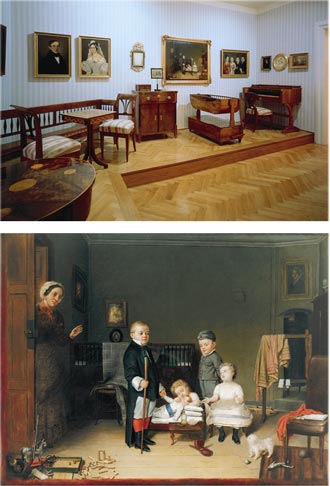Permanent Display 29. From the Homes of Zagreb People during the Biedermeier Period
 After the crisis brought about by the Napoleonic wars, the citizenry of Zagreb began to gain a certain degree of economic security, which had its effect on the way they lived and on their homes in the first part of the 19th century.
After the crisis brought about by the Napoleonic wars, the citizenry of Zagreb began to gain a certain degree of economic security, which had its effect on the way they lived and on their homes in the first part of the 19th century.
Defined as a typically bourgeois style, Biedermeier came to full expression in the way people arranged their flats and houses, manifested in the equipment of Zagreb homes. Satisfying the formula comfortable, simple and functional, the apartments of the citizens were arranged in a way that was identical to the style of the interiors in other Central European cities.
The furniture that was made by the carpenters of Gradec and Kaptol, who were members of separate guilds, features a great simplicity of form. The local craftsmen paid great attention to the treatment and choice of veneer, which in this period had a very important role. The simple inlaid ornamentation, the borders, the palmettes and scrolls were typical motifs which, with columns, made of black stained wood with gold capitals, lightened and vivified the chests and desks that had very solid forms.
Typical interior ambiences were created. A lady’s corner equipped with a dressing table, a writing desk on which there was a writing set and a lamp with a shade for a candle with the obligatory salver for letters. A little sewing table and a table for serving tea and coffee, with services for both of these, with many small pictures, and embroidered cushions were the typical accoutrements of the intimate world of the apartment of that period. Upholstered sofas in a suite, with a round or oval table, a number of smaller tables for cards and other games, display cabinets crammed with little objects, mementos of bygone days gave the sitting rooms a nostalgic appearance.
The ambiance and the arrangement of a modest flat was described by the writer and politician Imbro Tkalac in his Memoirs from Croatia, in which he mentioned all the main types of furniture of the time:
The furnishing of a decent drawing room consists of a sofa, several armchairs and chairs covered with woolen cloth or, more rarely, silk damask, then a round table, a mirror, and, perhaps, a glass-fronted cabinet for silver. Occasionally there will be a piano... In refined houses they eat from porcelain plates with silver cutlery. There are also dishes of stoneware, and of English Wedgwood; there will also be in addition dishes of pewter, and pewter spoons.
Nada Premerl

